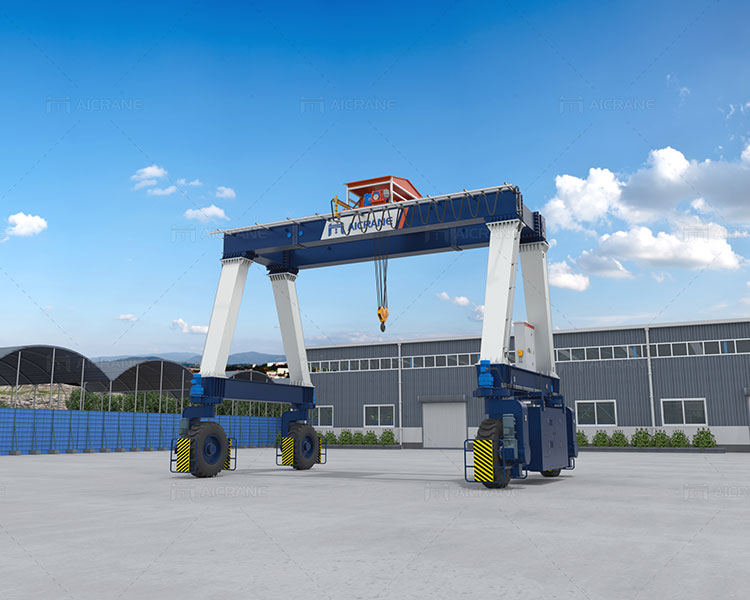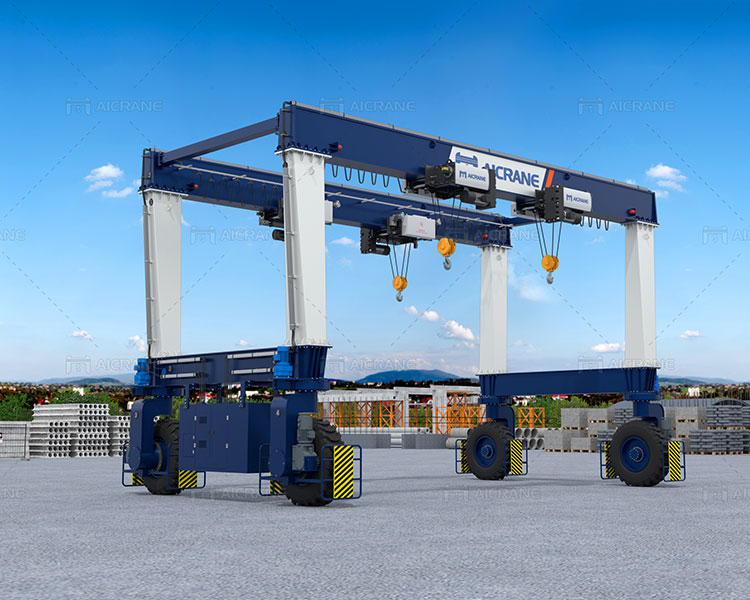Rubber Tyred Gantry (RTG) cranes are widely recognized for their indispensable role in container handling at ports and intermodal terminals. However, their utility extends far beyond these conventional applications. Industries across various sectors are increasingly leveraging the unique capabilities of RTG cranes to enhance operational efficiency, reduce costs, and manage heavy loads with precision. This article explores key applications of RTG cranes beyond ports, highlighting their versatility and adaptability.

1. Warehouse and Distribution Centers
In large warehouses and distribution centers, RTG crane is used to handle bulky goods and materials efficiently. These cranes are particularly advantageous in:
- Storage Optimization: RTG cranes can stack heavy materials vertically, maximizing warehouse space. This feature is especially beneficial for facilities with limited floor space.
- Efficient Material Handling: Their ability to handle diverse loads, from pallets to oversized equipment, ensures smooth operations in logistics and supply chain management.
The mobility of RTG cranes enables them to navigate different sections of the warehouse, making them a versatile alternative to traditional forklifts or static cranes.
2. Manufacturing Facilities
RTG cranes play a vital role in manufacturing environments where heavy equipment and raw materials need to be transported. Key applications include:
- Component Assembly: In industries like automotive or aerospace, RTG cranes are used to position and assemble large components with high precision.
- Production Line Support: Their capacity to move between different production lines facilitates the seamless transfer of heavy items, enhancing productivity.
3. Steel and Metal Industries
The steel and metal industries demand robust equipment to handle heavy and unwieldy materials. RTG cranes excel in:
- Transporting Steel Coils and Sheets: Their high load capacity and flexible operation make RTG cranes ideal for moving steel coils, sheets, and beams.
- Yard Management: These gantry mobile cranes can efficiently manage storage yards, organizing materials for easy access and minimizing the time spent searching for specific items.
4. Precast Concrete Production
In the construction industry, RTG cranes have proven their worth in handling precast concrete components. Their applications include:
- Precast Yard Operations: RTG cranes can transport and stack precast beams, slabs, and panels, ensuring efficient use of yard space.
- On-Site Installation: These cranes can be deployed at construction sites to lift and position precast elements, reducing reliance on multiple pieces of equipment.

5. Power Plants
RTG cranes contribute to the efficient handling of equipment and materials in power plants. Key uses include:
- Turbine and Generator Maintenance: Their precision and high load capacity make RTG cranes suitable for lifting and placing heavy machinery during maintenance or installation.
- Fuel Handling: In coal-fired power plants, RTG cranes can transport coal or other materials to designated areas, ensuring smooth operations.
6. Mining and Quarrying
The mining and quarrying sectors often require robust material handling solutions, and RTG cranes fit the bill perfectly. Their applications include:
- Material Loading and Unloading: RTG cranes can handle bulk materials such as ore, stone, or sand with ease.
- Equipment Maintenance: They can lift and position heavy mining equipment for repair or servicing, minimizing downtime.
7. Railway Yards and Depots
In railway yards and depots, RTG cranes play a pivotal role in maintaining and managing rolling stock. Applications include:
- Carriage and Locomotive Handling: RTG cranes can lift and position train carriages and locomotives during maintenance or assembly.
- Material Handling: These railway gantry cranes are also used to load and unload materials required for railway construction or repair projects.
8. Aviation Industry
The aviation industry benefits from the precision and reliability of RTG cranes in several ways:
- Aircraft Component Handling: RTG cranes can move large aircraft parts, such as wings or fuselage sections, during assembly.
- Maintenance Operations: They are used in maintenance hangars to lift and position aircraft for repairs or inspections.
9. Shipyards and Marine Applications
Shipyards are another area where RTG cranes shine. Their applications include:
- Shipbuilding: RTG cranes can lift and position heavy ship components during construction.
- Mooring and Dock Operations: They assist in handling cargo and equipment at docks, ensuring smooth operations in marine logistics.
10. Renewable Energy Projects
As the world shifts towards renewable energy, RTG cranes are finding new applications in this sector:
- Wind Turbine Assembly: RTG cranes can handle large turbine components, such as blades and nacelles, with precision.
- Solar Panel Installation: They are used to transport and position heavy solar panel arrays in solar farms.
Advantages of Using RTG Cranes in Non-Port Applications
The adaptability of RTG cranes lies in their design and capabilities. Here are some advantages that make them ideal for diverse industries:
- Mobility: Unlike rail mounted crane, RTG cranes can move across different areas without the need for fixed tracks, offering unmatched flexibility.
- High Load Capacity: With the ability to handle heavy loads, RTG cranes are suitable for industries dealing with bulky materials.
- Customization: Modern RTG cranes can be tailored to meet specific industry requirements, such as specialized spreaders or enhanced safety features.
- Operational Efficiency: Their precision and ease of operation reduce material handling time, leading to improved overall productivity.
Conclusion
While RTG cranes are most commonly associated with container handling at ports, their applications extend to a wide range of industries, from manufacturing and mining to renewable energy and aviation. Their mobility, high load capacity, and ability to operate in diverse environments make them an invaluable asset for businesses seeking efficient material handling solutions.
By exploring the potential of RTG cranes beyond traditional settings, industries can unlock new opportunities for operational efficiency and cost savings. Whether it’s stacking steel coils, assembling wind turbines, or managing warehouse logistics, RTG cranes prove their versatility time and again.